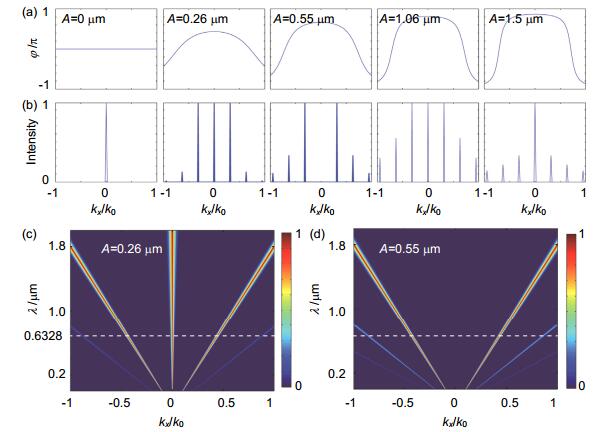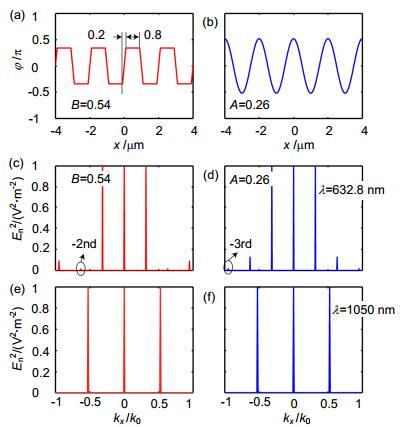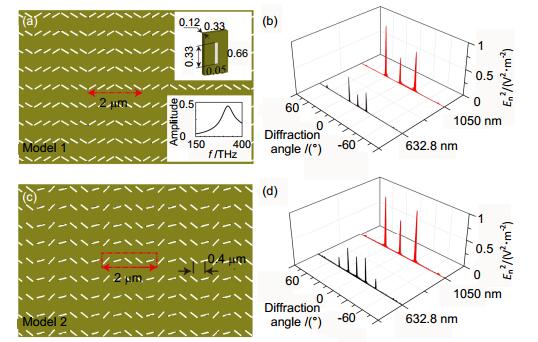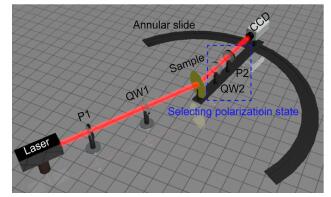-
Abstract:
It has been successfully demonstrated can be widely used in nano-photonics applications owing to their flexible wavefront manipulation in a limited physical profile. However, how to improve the efficiency for the transmission light is still a challenge. We experimentally demonstrate that the sine-shaped metallic meanderline fabricated by focus ion beam technology converts circularly polarized (CP) light to its opposite handedness and sends them into different propagation directions depending on the polarization states in near-infrared and visible frequency regions. The beam splitting behavior is well characterized by a simple geometry relation, following the rule concluded from other works on the wavefront manipulation of metasurface with phase discontinuity. Importantly, the meanderline is demonstrated to be more efficient in realizing the same functions due to the suppressed high order diffractions resulted from the absence of interruption in phase profile. The theoretical efficiency reaches 67%. Particularly, potential improvements are feasible by changing or optimizing shape of the meanderline, offering high flexibility in applications for optical imaging, communications and other phase-relative techniques. Additionally, since the continuous phase provided by the meanderline can improve the sampling efficiency of the phase function, it is helpful in realizing high quality hologram.

-
Key words:
- electromagnetic wave /
- metamaterials /
- super-resolution /
- flat lens /
- absorber
-

Abstract: The seminal study reported in 2011 demonstrated that arbitrary abrupt phase of scattering wave in 2π range can be realized by spatially tailoring the geometry of nanoantennas with deep-subwavelength sizes both in horizontal and vertical directions. Quite different from the traditional optics, the abrupt phase is generated from the resonance of the nanoantenna, rather than the accumulation of propagation in space or dielectric materials. Thereupon, metasurfaces composed of such nanoantennas can break the thickness limitation of traditional optical devices, with the advantage of flexible phase distribution arrangement, leading to a bright prospect in highly integrated nano-optical system. A lot of works have been reported that metasurfaces are ability of flexibly manipulating the wavefront of scattering, leading to applications of ultrathin flat metalenses, beam shaper, quarter-wave plates, optical holography, optical vortices generation, anomalous light bend etc. Although the metasurface is regarded as the alternative for the next generation optical device, how to improve the efficiency for the transmission light is still a challenge. Two approaches are generally used. One is to set the operation mode as reflection, i.e. the light source and the target light are on the same plane respect to the metasurface. Nanoantennas with high reflective coefficient are easier to be designed in comparison with high transmission coefficient, especially in metallic metasurfaces. The other way is to replace the host material as dielectric. Due to the low loss, ratio of the transmitted port of incoming light is weighted. The cost, however, is the increased profile. In popular, all the metasurfaces mentioned above are discrete, i.e. the neighbor nanoantennas are unconnected in physical configuration, yielding a phase profile of discontinuous. In this paper, we verify that structure of phase continuity can enhance the manipulation efficiency by suppressing high-order diffractions of nanoantennas. The sine-shaped metallic meanderline fabricated by focused ion beam technology converts circularly polarized (CP) light to its opposite handedness and sends it into different propagation directions depending on the polarization states in near-infrared and visible frequency regions. The beam splitting behavior is well characterized by a simple geometry relation, following the rule concluded from other works on the wavefront manipulation of metasurface with phase discontinuity. Importantly, the meanderline is demonstrated to be more efficient in realizing same functions due to the suppressed high order diffractions resulted from the absence of interruption in phase profile. The theoretical efficiency reaches 67%. Particularly, potential improvements are feasible by changing or optimizing shape of the meanderline, offering high flexibility in applications for optical imaging, communications and other phase-relative techniques. Additionally, since the continuous phase provided by the meanderline can improve the sampling efficiency of the phase function, it is helpful in realizing high quality hologram.
-

-
Figure 1. Design and fabrication of the sine-shaped metallic meanderlines. (a) Curve function of the thin red line is f(x) = A sin(πx), where A is the amplitude coefficient. The single element is formed via broadening the curve along y axis. The width of the metallic wire along meanderline is w which achieves the maximal value δ at each inflexion of the curve. Periods along x and y directions are P = 2 μm and Py, respectively. (b) Repeating the element along x and y directions in items of the periods, we finally finish the design of the meanderline samples. SEM top images of fabricated Sample 1 (c) containing 15 × 17 periods and Sample 2 (d) composed of 15 × 25 along x and y directions. Physical parameters of the two samples are noted in the pictures. The inset in (d) shows the details of Sample 2 with the scale bar of 1 μm long. The maximal width difference along the meanderline is less than 9 nm, as the red marked arrows shows.
Figure 2. Simulated and measured spectra of the converted CP light. Simulations are processed with the commercial electromagnetic simulation soft of CST 2013. (a), (c), (e) show the spectra of Sample 1 and (b), (d), (f) are the results of Sample 2 at incident wavelengths of 532 nm, 632.8 nm, and 785 nm. The tiny fluctuations around the peaks in experimental data are ignored in the post processing. Intensity data below tenth of the maximum are ignored in consideration of the camera limitation, leading to the absence of the center spectra for Sample 2.
Figure 3. Effect of amplitude coefficient A on phase profile and wavefront manipulation. Phase profile in a period of the proposed sine function (a) and the corresponding converted CP light spectra (b) for various A values. Spectra as a function of incident wavelength λ and relative wave vector kx/k0 are given for different A values of 0.26 μm (c) and 0.55 μm (d), respectively. The broken white line is marked at the wavelength of 632.8 nm.
Figure 4. Wavefront manipulation of meanderlines with different phase-continuity profiles. (a) A typical phase profile of the triangle grating. We set a square-wave function with certain rising and trailing edges to mimic the phase of electric field of the triangle grating. (b) Phase profile introduced by the sine-function we proposed. (c) and (d) show the 1D spectra of the converted CP light at 632.8 nm for the two kinds of phase profiles normalized by the sine-function one. (e) and (f) are the 1D spectra at 1050 nm for the two cases.
Figure 5. Metasurfaces with phase-discontinuity to realize the similar function of splitting the converted CP light beam. The structure in (a) possesses six discrete unit cells in a period to mimic the profile in Fig. 5(a). The upper inset shows the dimension of the unit cell. The lower one is the polarization conversion ratio from LCP to RCP light. The peak is around 285.7 THz. Normalized spectra at 632.8 nm and 1050 nm are depicted in (b) with diffraction angles of ±18.4° and ± 31.5°. The metasurface in (c) contains five slits with different rotation angles in a period to approximate the phase profile in Fig. 5(b). Normalized spectra of converted CP light beam are shown in (d).
Figure 6. Schematic of the optical set-up for beam splitting measurement. An input beam from a laser source is adjusted to be left-handed circularly polarized (LCP) after a horizontal direction polarizer (P1) and a 45° rotated quarter-wave plate (QW1), and then impinges on the sample. Light beams with opposite-handed component, i.e. RCP, are picked out using a cascaded horizontal direction quarter-wave (QW2) plate and polarizer (P2) fixed on a metallic arm connecting to a semi-annular slide rail with radius of 30 cm, and finally received by a CCD camera moving along the slide rail.
Table 1. Efficiency comparison for the meanderline and metasurfaces of phase discontinuity
Efficiency ratio @ 632.8 nm @ 1050 nm Meanderline 1.0 0.823 Discrete model 1 0.477 0.444 Discrete model 2 0.556 0.485 -
[1] Yu Nanfang, Capasso F. Flat optics with designer metasurfaces[J]. Nature Materials, 2014, 13(2): 139-150. doi: 10.1038/nmat3839
[2] O'Shea D C, Suleski T J, Kathman A D, et al. Diffractive Optics: Design, Fabrication, and Test[M]. Bellingham, WA: SPIE Press, 2003.
[3] Luo Xiangang, Pu Mingbo, Ma Xiaoliang, et al. Taming the electromagnetic boundaries via metasurfaces: from theory and fabrication to functional devices[J]. International Journal of Antennas and Propagation, 2015, 2015: 204127. https://www.researchgate.net/publication/281677037_Taming_the_Electromagnetic_Boundaries_via_Metasurfaces_From_Theory_and_Fabrication_to_Functional_Devices
[4] Yu N F, Genevet P, Kats M A, et al. Light propagation with phase discontinuities: generalized laws of reflection and refraction[J]. Science, 2011, 334(6054): 333-337. doi: 10.1126/science.1210713
[5] Yang Y, Wang W, Moitra P, et al. Dielectric meta-reflectarray for broadband linear polarization conversion and optical vortex generation[J]. Nano Letters, 2014, 14(3): 1394-1399. doi: 10.1021/nl4044482
[6] Pu Mingbo, Chen Po, Wang Yanqin, et al. Anisotropic meta-mirror for achromatic electromagnetic polarization manipulation[J]. Applied Physics Letters, 2013, 102(13): 131906. doi: 10.1063/1.4799162
[7] Pu Mingbo, Zhao Zeyu, Wang Yanqin, et al. Spatially and spectrally engineered spin-orbit interaction for achromatic virtual shaping[J].Scientific Reports, 2015, 5: 9822. doi: 10.1038/srep09822
[8] Huang Lingling, Chen Xianzhong, Bai Benfang, et al. Helicity dependent directional surface plasmon polariton excitation using a metasurface with interfacial phase discontinuity[J]. Light: Science & Applications, 2013, 2(3): e70. https://www.researchgate.net/profile/Benfeng_Bai/publication/236002864_Helicity_Dependent_Directional_Surface_Plasmon_Polariton_Excitation_Using_A_Metasurface_with_Interfacial_Phase_Discontinuity/links/00b4953c5c7b88faca000000.pdf
[9] Pelzman C, Cho S Y. Polarization-selective optical transmission through a plasmonic metasurface[J]. Applied Physics Letters, 2015, 106(25): 251101. doi: 10.1063/1.4922993
[10] Zhao Zeyu, Pu Mingbo, Gao Hui, et al. Multispectral optical metasurfaces enabled by achromatic phase transition[J]. Scientific Reports, 2015, 5: 15781. doi: 10.1038/srep15781
[11] Alali F, Kim Y H, Baev A, et al. Plasmon-enhanced metasurfaces for controlling optical polarization[J]. ACS Photonics, 2014, 1(6): 507-515. doi: 10.1021/ph5000192
[12] Shaltout A, Liu Jingjing, Shalaev V M, et al. Optically active metasurface with non-chiral plasmonic nanoantennas[J]. Nano Letters, 2014, 14(8): 4426-4431. doi: 10.1021/nl501396d
[13] Pu Mingbo, Li Xiong, Ma Xiaoliang, et al. Catenary optics for achromatic generation of perfect optical angular momentum[J]. Science Advances, 2015, 1(9): e1500396. doi: 10.1126/sciadv.1500396
[14] Aieta F, Genevet P, Yu Nanfang, et al. Out-of-plane reflection and refraction of light by anisotropic optical antenna metasurfaces with phase discontinuities[J]. Nano Letters, 2012, 12(3): 1702-1706. doi: 10.1021/nl300204s
[15] Pu Mingbo, Chen Po, Wang Changtao, et al. Broadband anomalous reflection based on gradient low-Q meta-surface[J]. AIP Advance, 2013, 3(5): 052136. doi: 10.1063/1.4809548
[16] Ni Xingjie, Emani N K, Kildishev A V, et al. Broadband light bending with plasmonic nanoantennas[J]. Science, 2012, 335(6067): 427. doi: 10.1126/science.1214686
[17] Pors A, Albrektsen O, Radko I P, et al. Gap plasmon-based metasurfaces for total control of reflected light[J]. Scientific Reports, 2013, 3: 2155. doi: 10.1038/srep02155
[18] Ma Xiaoliang, Pu Mingbo, Li Xiong, et al. A planar chiral meta-surface for optical vortex generation and focusing[J]. Scientific Reports, 2015, 5: 10365. doi: 10.1038/srep10365
[19] Yu Nanfang, Aieta F, Genevet P, et al. A broadband, background-free quarter-wave plate based on plasmonic metasurfaces[J]. Nano Letters, 2012, 12(12): 6328-6333. doi: 10.1021/nl303445u
[20] Li Xiong, Pu Mingbo, Wang Yanqin, et al. Dynamic control of the extraordinary optical scattering in semicontinuous 2D metamaterials[J]. Advanced Optical Materials, 2016, 4(5): 659- 663. doi: 10.1002/adom.v4.5
[21] Guo Yinghui, Yan Lianshan, Pan Wei, et al. Scattering engineering in continuously shaped metasurface: an approach for electromagnetic illusion[J]. Scientific Reports, 2016, 6: 30154. doi: 10.1038/srep30154
[22] Hu Dan, Wang Xinke, Feng Shengfei, et al. Ultrathin terahertz planar elements[J]. Advanced Optical Materials, 2013, 1(2): 186-191. doi: 10.1002/adom.201200044
[23] Aieta F, Genevet P, Kats M A, et al. Aberration-free ultrathin flat lenses and axicons at telecom wavelengths based on plasmonic metasurfaces[J]. Nano Letters, 2012, 12(9): 4932-4936. doi: 10.1021/nl302516v
[24] Chen Xianzhong, Huang Lingling, Mühlenbernd H, et al. Dual-polarity plasmonic metalens for visible light[J]. Nature Communications, 2012, 3: 1198. doi: 10.1038/ncomms2207
[25] Chen Xianzhong, Zhang Yan, Huang Lingling, et al. Ultrathin metasurface laser beam shaper[J]. Advanced Optical Materials, 2014, 2(10): 978-982. doi: 10.1002/adom.v2.10
[26] He J W, Ye J S, Wang X K, et al. A broadband terahertz ultrathin multi-focus lens[J]. Scientific Reports, 2016, 6: 28800. doi: 10.1038/srep28800
[27] Zhao Yang, Alù A. Tailoring the dispersion of plasmonic nanorods to realize broadband optical meta-waveplates[J]. Nano Letters, 2013, 13(3): 1086-1091. doi: 10.1021/nl304392b
[28] Zhang Xiaohu, Jin Jinjin, Wang Yanqin, et al. Metasurface-b ased broadband hologram with high tolerance to fabrication errors[J]. Scientific Reports, 2016, 6: 19856. doi: 10.1038/srep19856
[29] Ni Xingjie, Kildishev A V, Shalaev V M. Metasurface holograms for visible light[J]. Nature Communications, 2013, 4: 2807. doi: 10.1038/ncomms3807
[30] Chen Weiting, Yang Kuangyu, Wang C M, et al. High-efficiency broadband meta-hologram with polarization-controlled dual images[J]. Nano Letters, 2014, 14(1): 225-230. doi: 10.1021/nl403811d
[31] Zheng Guoxing, Mühlenbernd H, Kenney M, et al. Metasurface holograms reaching 80% efficiency[J]. Nature Nanotechnology, 2015, 10(4): 308-312. doi: 10.1038/nnano.2015.2
[32] Lin Jiao, Mueller J P B, Wang Qian, et al. Polarization-controlled tunable directional coupling of surface plasmon polaritons[J]. Science, 2013, 340(6130): 331-334. doi: 10.1126/science.1233746
[33] Yin Xiaobo, Ye Ziliang, Rho J, et al. Photonic spin hall effect at metasurfaces[J]. Science, 2013, 339(6126): 1405-1407. doi: 10.1126/science.1231758
[34] Ma Guancong, Yang Min, Xiao Songwen, et al. Acoustic metasurface with hybrid resonances[J]. Nature Materials, 2014, 13(9): 873-878. doi: 10.1038/nmat3994
[35] Li Yong, Jiang Xue, Li Ruiqi, et al. Experimental realization of full control of reflected waves with subwavelength acoustic metasurfaces[J]. Physical Review Applied, 2014, 2(6): 064002. doi: 10.1103/PhysRevApplied.2.064002
[36] Werner D H, Kwon D H. Transformation Electromagnetics and Metamaterials: Fundamental Principles and Applications[M]. London: Springer, 2014.
[37] Luo Xiangang. Principles of electromagnetic waves in metasurfaces[J]. Science China Physics, Mechanics & Astronomy, 2015, 58(9): 594201. https://link.springer.com/article/10.1007/s11433-015-5688-1
[38] Ding X, Monticone F, Zhang K, et al. Ultrathin pancharatnam- berry metasurface with maximal cross-polarization efficiency[J]. Advanced Materials, 2015, 27: 1195-1200. doi: 10.1002/adma.201405047
[39] Aieta F, Genevet P, Kats M, et al. Aberrations of flat lenses and aplanatic metasurfaces[J]. Optics Express, 2013, 21(25): 31530-31539. doi: 10.1364/OE.21.031530
[40] Zhang Lei, Hao Jiaming, Qiu Min, et al. Anomalous behavior of nearly-entire visible band manipulated with degenerated image dipole array[J]. Nanoscale, 2014, 6(21): 12303-12309. doi: 10.1039/C4NR03163F
-


 E-mail Alert
E-mail Alert RSS
RSS
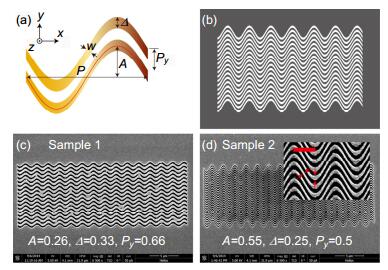
 下载:
下载:

